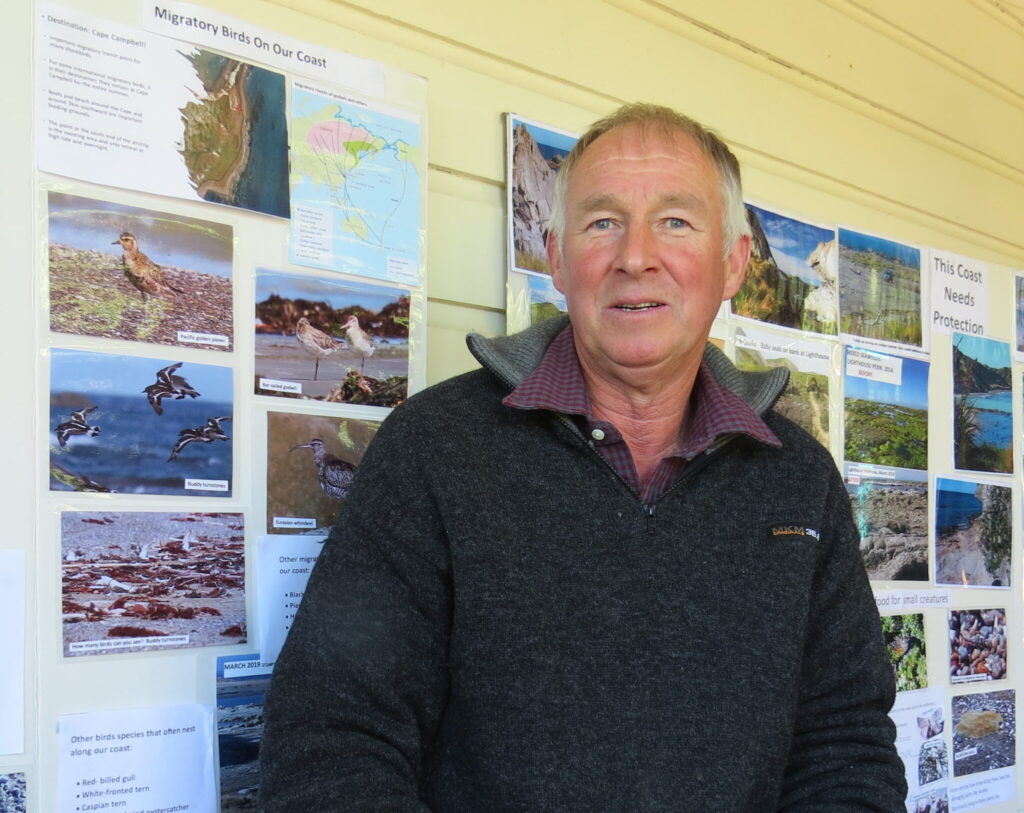By Joanna Grigg
Farming couple Rob and Sally Peter have rallied neighbours to help improve bird survival on their farm coastline. The collaboration is working, with the East Coast Protection Group winning a coveted Marlborough award.
While the Peters’ Poll Dorset ewes crack a lambing percent of 135%, birds on Cape Campbell’s beachfront are being decimated by predators. The ground-nesting Banded Dotterel colony produced only eight surviving chicks from 120 eggs laid in 2022/23.
Sally said that, until monitoring started, they didn’t really know how bad the situation was.
“We were aware the Little Blue Penguin had gone and tried to help by running predator traplines, which we’d check after shifting sheep.”
“We always carried a gun to shoot predators – cats just thrive out here in the dry.”
The Peters have farmed the block for 50 years. It was reading archaeological records from the 1300s and the lighthouse keepers’ notes about the beach life that were the most motivating for Rob.
“They talked about thousands of birds on the beach but we were seeing far fewer.”
Cape Campbell is a key stop for migratory birds and resident seabird populations – including threatened species. It’s infamous for holding the record for the driest place in New Zealand over six months, with just 51mm of rain. The 2016 earthquake lifted the intertidal area and dried it out, robbing habitat and making vehicle access easier – the perfect storm.
In response, the Peters helped set up the East Coast Protection Group (ECPG) in 2017, along with neighbours and other conservation-minded people. The group monitors wildlife, traps predators, gets rid of weeds and restores native plantings.
It was recently named winner of the Landscape & Habitat Enhancement Award at the Cawthron Marlborough Environment Awards.
The 2016 earthquake helped bring some funds in to monitor the site but it was the Jobs for Nature Programme that became the key source of funding for predator and weed control and monitoring.

Shannon Mears, Mears Contracting, is the key contractor. She said 241 traps are serviced fortnightly with the longest trap line being 10km.
“Feral cats are the biggest problem but hedgehogs are ferocious and decimate birds’ nests.”
Over the past two years 139 cats and 946 hedgehogs, as well as stoats, weasels and ferrets, were trapped. Despite this, camera monitoring of the 120 eggs laid by Banded Dotterel in 2022/23 showed that 70 eggs were predated by cats. Mears rates the SA2 cat traps as being very effective, especially when baited with fresh rabbit or fish. Traps painted with fish oil will lure them in as well as “a flapping bird wing”.
Sonia Roxburgh does the monitoring work for the group. Migratory birds that stop over include Ruddy Turnstones, Bar-Tailed Godwits and Eurasian Whimbrels. In 2021 only one Variable Oyster Catcher (Black) hatched along 42km. Fifty years ago there was a big colony of White Fronted Terns here, she said, but now there are just 130 birds.
Restricting vehicle and dog access to the beach was suggested by the group, although not without pushback from recreational users. Nests on the beach were being disturbed by off-road vehicles. After consultation, council bylaws were put in place to exclude vehicles from most of the coast from the Awatere River to the Waimea/Ure. Dog access is tightly restricted.
Rick Stolwerk, ECPG Chair, said that 90% of the group’s funding is via the government-funded Jobs for Nature scheme ($100,000/year).
“We have nine months of funding left.”
He said $120,000 is needed to continue existing levels of control and monitoring but they would also like to carry out pest control for 1km inland from the beach, and start marine monitoring. The idea is to catch the cats before they reach the nests.
“We are only maintaining the status quo – I’d like to say we’ve stopped the decline but I’m not sure.
“We really need to extend control across a buffer zone.”
The Peters have made a major financial contribution by fencing off 10km of the farm from the beachfront. They were the first in Marlborough to voluntarily sign-up areas of the farm as Significant Natural Areas (SNAs), with four registered in 2000. They also have two QUE II Reserves and have linked these up with stock exclusion areas and plantings.
“We will continue to put more land in reserves voluntarily, whatever the future regulations,” Rob said.
Mike Aviss, biodiversity co-ordinator at Marlborough District Council, said the purpose of SNAs is to allow the council to help manage biodiversity on private land. He said almost all landowners within the ECPG have identified SNAs and all are very significant.
“Some areas have 20 or more endangered species.”
He said the earthquake actually helped replanting in some ways, as a clean ribbon of sand was exposed, without the invasive marram grass.
“We could plant indigenous species into it.”
Close to 30,000 plants have been planted in the sand, including trees to eventually shade out the marram grass. Aviss applied to One Billion Trees for funding to plant on the public land areas along the 42km stretch of coastline. He said that 90% of the farmers across Marlborough who have SNAs on their farms are really engaged and allow him access to check on their status. Sally said the SNA process in Marlborough has been done very well.
“The council staff were respectful and it has been a learning process at our pace, not intimidating – Marlborough should be proud.”
The group hosted a field day last week to showcase its work, as part of the 2023 Cawthron Marlborough Environment Awards.










